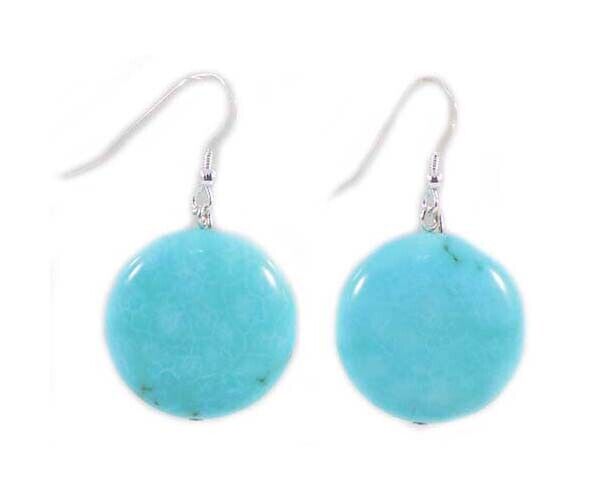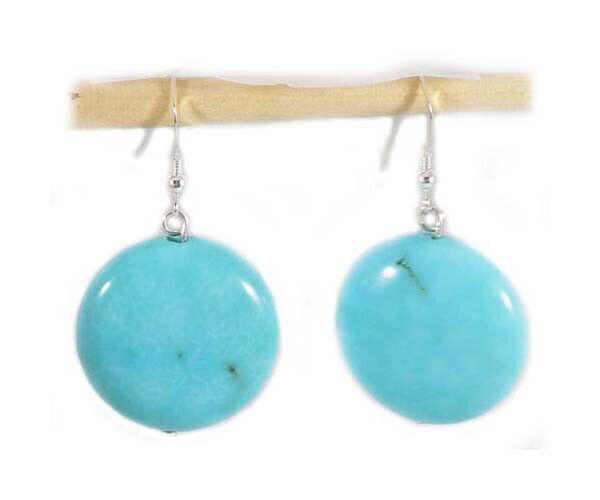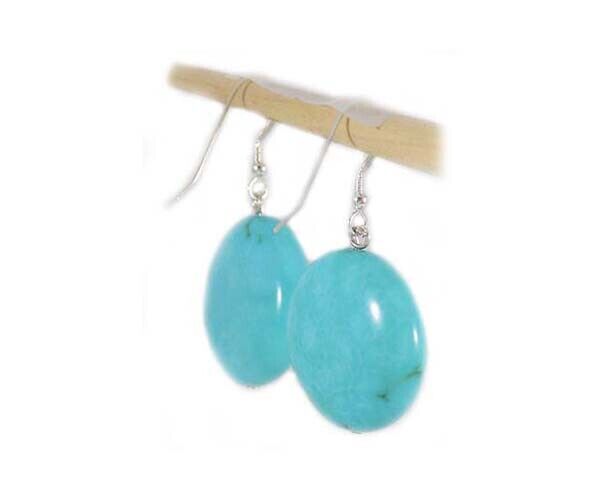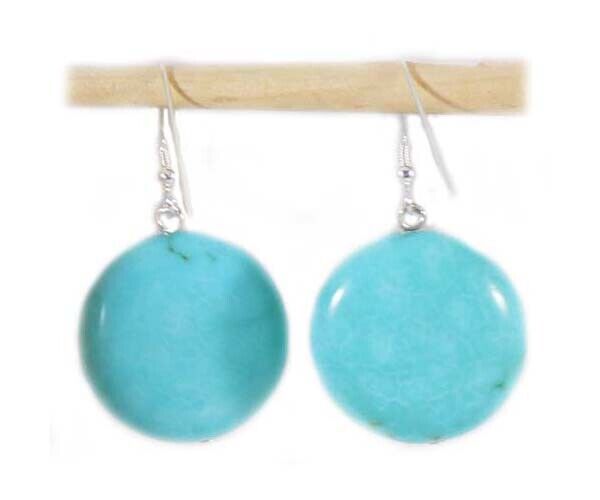-40%
Turquoise Earring Ancient American Indian Gem of Immortals Antique 94ct Beads
$ 42.23
- Description
- Size Guide
Description
Two Antique Nineteenth Century Genuine Natural Siberian Turquoise (Combined 94 Carats in Weight) Semi-Precious Gemstones. Mounted into contemporary high quality sterling silver french hooks.CLASSIFICATION:
Gemstone Quality Turquoise Cabochons.
ORIGIN:
19th Century Siberia, Russia.
SIZE
: Diameter: 24mm. Depth: 8mm. All measurements approximate.
WEIGHT
: 93.95 carats (the pair).
NOTE
: These earring settings are also available in solid 14kt gold as well as 14kt gold fill (5% gold over 95% silver). Other setting styles (studs, euro clicks, lever backs, kidney wires, ball/stud dangles) are available upon request, both in sterling silver, as well as 14kt solid gold and in 14kt gold fill. Contact us, we can send you pictures upon request
DETAIL:
Although in classical antiquity the source of turquoise was (in 6000BC) the Egyptian Sinai Desert, then from the Persian mines in present day Iran (from 4,000BC), and augmented by supplies from China and Tibet via the Northern Silk Route, at the same time turquoise was also highly valued in Ancient MesoAmerica. Turquoise was sacred to many American Indian tribes and many tribes of ancient Mexico held that mere mortals were not even permitted to wear turquoise, which was reserved exclusively for the Gods. Most Native American tribes believed that a deep connection existed between the spirits residing in the blue sky and the blue stone found in the earth. The Aztecs of Mexico for example commonly used turquoise for their fine mosaic art and knew the gemstone as “chalchihuitl”.
The Zuni (of present-day New Mexico) carved fetishes and talismans in the forms of animals, insects and other living shapes, and believed that blue turquoise was “male”, and came from the sky; and that green turquoise was “female”, and came from the earth. Apache medicine men and shaman regarded turquoise as absolutely essential. Following a rainbow resulted not in a pot of gold but turquoise. Aiding the accuracy of a hunter's aim was another power highly valued by the Apache. The Apache believed that turquoise combined the spirit of water and of the sky to protect the wearer from all natural calamities. The Navaho believed that turquoise, when thrown into a river, would bring rain.
Celebrating this cultural legacy, here's a pair of beautiful, elegant, richly colored Siberian turquoise semi-precious gemstones. The gemstones were hand crafted by a 19th century Russian artisan for use in domestic jewelry part of an heritage renown for the production of the elaborate gemstones and jewelry of the Czars of Medieval, Renaissance, and Victorian Russia. The gemstones were most likely originally part of a necklace, however lacking the original setting, we remounted them into the gorgeous earrings you see here.
The earring settings are of contemporary origin. They are high quality settings manufactured by one of the USA’s leading semi-custom mount producers. They are constructed of sterling silver; they are not cheap, silver electroplated earrings. It is genuine sterling silver, designed to last a lifetime. It's a first-class piece of jewelry throughout. There are many other setting styles available which, in sterling silver, could be substituted for either no or nominal extra cost. Please write us, ask, we can send you photos of the various alternative earring styles available. We can also reset the gemstones into 14kt solid gold or 14kt gold fill upon request.
As might be expected under magnification the gemstone shows the unmistakable, hallmark characteristics of having been hand crafted. The coarseness of the 19th century finish is considered desirable to most gemstone aficionados, and is not considered a detriment, or detract from the value of a gemstone. These characteristics are not only expected of hand-finished gemstones, many believe that such antique hand-crafted gemstones possess much greater character and appeal than today's mass-produced, laser-cut gemstones. Unlike today’s computer controlled machine produced gemstones that approach flawlessness in a perfect finish, the cut and finish of an antique, handcrafted gemstone such as this is the legacy of an artisan who lived two centuries ago.
Handcrafted though they may be the gemstones possess great luster and character, but that is not to imply that they are without flaw. True, the blemishes they possess are not immediately discerned with the naked eye, and to the view of the casual admirer the gemstones are indeed seemingly without blemish. However in the accompanying photo enlargements you can surely discern a few tiny blemishes as well as occasional irregularities in the cut and finish. Naturally much the same may said about almost any antique, handcrafted gemstones of natural origin. Most absolutely flawless gemstones will upon close examination be revealed to be synthetic. Furthermore these characteristics are not only expected of hand-finished gemstones, you must also consider that two centuries ago the mining techniques even possible then, let alone in practice, did not allow the ultra deep mining operations which are so commonplace today.
Keep in mind two centuries ago mankind was more or less limited to surface deposits or near surface deposits of gemstones. Higher quality gemstones which today are routinely mined from beneath hundreds of meters, even kilometers beneath the earth's surface, were simply inaccessible then. It is precisely for these reasons antique gemstone must be appreciated as antiques first, gemstones second. The relatively superlative quality of contemporary gemstones mined from deep beneath the earth's surface were simply not accessible two centuries ago, or at least, only rarely so. But for most, the unique nature and character of these antique gemstones more than makes up for the blemishes found within the gemstones, as well as the cutting and finishing irregularities common to handcrafted gemstones, all of which are by and large are only visible under magnification.
HISTORY OF TURQUOISE:
Turquoise was mined by the ancient Egyptians in the Sinai Peninsula from around 6,000 B.C. onwards in one of the world's first important hard-rock mining operations. Archaeological evidence suggests that by 4,000 B.C., the turquoise mines in the Sinai had already been exhausted, so popular was turquoise in the ancient world. Fortunately the ancient world had a second source of turquoise, Persia. The sky-blue variety of turquoise, commonly referred to as robin's egg, is and historically has been the most desired variety. This variety is mined exclusively in present-day Neyshabur, Iran.
Archaeologists also believe that it is possible that some turquoise came to the Near East and the Eastern Mediterranean from China via the Northern Silk Route. The mineral has been valued for its ornamental and talismanic properties since ancient times. In ancient Tibet and China, turquoise was oftentimes valued higher than gold, and was thought to attract prosperity. To the ancient Egyptians, turquoise was known as “mefkat”, meaning joy or delight. Ancient Egyptians carved turquoise into animal figures worn as symbols of their gods, believing that turquoise itself had divine powers. Turquoise has been found in neckwear and bracelets recovered along with the 7,500 year old Egyptian mummy of “Queen Zer”.
The ancient Egyptians not only used turquoise for jewelry, but also wore it as a talisman to keep evil away. Ancient Egyptian Priests stitched turquoise to their upper vests. In ancient Egypt, everyone from pharaoh to commoner wore turquoise. The ancient Persians themselves believed that health, wealth and happiness would be bestowed upon the wearer of turquoise, as reflected in an ancient Persian saying, “the wearer shall never be poor'”. It was worn around the neck or around the wrist in the belief that the wearer would be protected from an unnatural death.
As talismans, the ancient Persians also adorned daggers, sabers and the bridles of horses with turquoise. It was also believed by the ancient Persians that the gemstone would change color to warn the wearer of impending danger. The horse-mounted tribes of Central Asia (Huns, Scythians, Cimmerians, Avars, Magyars, Mongols) wore turquoise talismans with the belief that they would protect against falls, particularly those from horseback. Turquoise was also commonly carved into pendants and beads by the ancient Sumerians, "founders" of modern civilization, as far back as 5,000 B.C.
Some of the most splendid ancient jewelry ever unearthed by archaeologists was found in Queen Pu-abi's tomb at Ur in Sumeria dating from the 3rd millennium B.C., and in the ancient Egyptian Pharaoh Tutankhamen's tomb. Turquoise was one of the most prominent gemstones found within these tombs, including on the famous mask of Tutankhamen. Both the ancient Sumerians and Egyptians produced highly sophisticated gold ornaments inlaid with turquoise. In ancient India, Afghanistan, Arabia and Persia, it was believed that the subtle variations in the color of the stone could be read as indications of the health of the person wearing it, and it was widely believed to change color to expose a woman's infidelity.
Throughout ancient Asia as well as ancient Persia turquoise was believed to protect against the “evil eye”, related to the universal ancient belief that some evil sorcerers or witches had the ability to transmit evil with just a glance. In ancient Persia a turquoise gemstone was typically worn on a turban, often surrounded with pearls, in order to protect against the “evil eye”. Wearing turquoise as a talisman was also believed to protect one from floods. Though the ancient first century Roman Naturalist and Historian Pliny the Elder wrote of turquoise, known as “callais” to the ancient Romans, it is believed that turquoise wasn’t really widely introduced into Europe only in the Middle Ages (at the time of the first Crusades) by Venetian traders.
The trade route which developed saw turquoise being transported to Europe through Turkey, which probably accounts for the name “turquoise”, which is French for "Turkish." It was believed in Medieval Europe that a turquoise gemstone which changed color (became dehydrated) was a warning of impending danger for the wearer. Turquoise was also believed to awaken feelings of romantic love, and to enhance virtues such as trust, kindness, wisdom and understanding. Many Germanic peoples also used turquoise as a betrothal stone, and throughout Europe it was believed that wearing a turquoise amulet would protect travelers from violence, accidents, and injury.
Outside the classical world turquoise was also highly valued in Ancient MesoAmerica. As was the case in ancient Tibet, turquoise was sacred to many American Indian tribes. Most Native American tribes believed that a deep connection existed between the spirits residing in the blue sky and the blue stone found in the earth. Turquoise was also used by Native American shamans and healers in rituals and ceremonies. It was believed to enhance mental and spiritual clarity. There are also accounts of some Native American tribes using turquoise to decorate their teeth.
In particular Apache medicine men and shaman regarded turquoise as absolutely essential. Following a rainbow resulted not in a pot of gold but turquoise. Aiding the accuracy of a hunter's aim was another power highly valued by the Apache. The Apache believed that turquoise combined the spirit of water (as in lakes and rivers) and of the sky to protect the wearer from all natural calamities. The Navaho believed that turquoise, when thrown into a river, would bring rain.
The Zuni (of present-day New Mexico) in particular carved fetishes and talismans in the forms of animals, insects and other living shapes. Interestingly the Zuni believed that blue turquoise was “male”, and came from the sky; and that green turquoise was “female”, and came from the earth. Further south to some tribes of ancient Mexico, mere mortals were not permitted to wear turquoise, which was reserved exclusively for the Gods. The Aztecs of Mexico used turquoise for their fine mosaic art and introduced the stone to the surrounding areas, where it became known as “chalchihuitl”.
The color of turquoise ranges from blue and blue-green to greenish-gray, according to the various amounts of copper usually present. Like opal, turquoise is opaque, reflecting light from small transparent layers within the stone. Turquoise sometimes is "matrixed" (known as a “spider web matrix”) with varying shades of gray, brown, or black veins due to the inclusion of various oxides and impurities (often silver), and is greatly desired by many collectors. However the most valuable turquoise is still mined from Neyshabur, Iran, and is known as “robin’s egg blue”, though as is oftentimes seen with ancient specimens of turquoise, when exposed to sunlight or heat, this variety becomes dehydrated and turns "turquoise" green.
Other less desirable deposits of turquoise are found in the Southwestern United States, the Sinai peninsula, Africa, Australia, Siberia, and Europe. Turquoise is typically found in association with and regarded as a by-product of copper mining. It is formed when a chemical reaction takes place after water slowly enters into the rocks containing copper, aluminum, zinc and other phosphates. Bluer turquoise is due to the presence of copper in the gem, greener turquoise due to higher concentrations of iron or aluminum, and yellowish green color due to traces of zinc.
Being relatively soft, turquoise gemstones are sensitive, easily discolored by chemicals, or even the oils and perspiration of the wearer’s skin. As the color may pale when the stone has been worn for a long time, even high-quality stones today are treated with wax or resin and subsequently hardened. This treatment makes the sensitive gemstone more resistant. Turquoise which has a good natural color and is simply hardened with colorless wax or resin has a much higher value than stones whose color has been “improved” with the use of dye.
Throughout the history of the ancient world, gemstones were believed capable of curing illness, possessed of valuable metaphysical properties, and providing protection. Found in Egypt dated 1500 B.C., the "Papyrus Ebers" offered one of most complete therapeutic manuscripts containing prescriptions using gemstones and minerals. Gemstones were not only valued for their medicinal and protective properties, but also for educational and spiritual enhancement. In the ancient world turquoise was thought to protect against reptile and insect bites (and was even used as an antidote), poisons, eye diseases, accidents and violence.
Turquoise was also used to treat muscle aches, pains and soreness, arthritis of the hip, infections, stomach disorders, and bleeding. It was oftentimes used to treat respiratory disorders including asthma, sore throat, and to treat dental complaints. It was also believed to be a cure for blindness, and was sometimes used to predict the weather based on the perceived color changes of the gemstone. On the metaphysical plane, turquoise was thought to facilitate attunement between the physical plane and higher planes of existence, and to foster spiritual growth and awareness.
Turquoise was considered to be a protective stone, a healer of the spirit, providing soothing energy and peace of mind, benefiting those people suffering from low spirits or depression. Turquoise was believed to protect against curses, psychic or magical attacks (sorcery), and was believed to guard babies and young children. On the more profane side, Turquoise was also believed to bring spoils to warriors, and many kills to the hunter. New Age healers regard turquoise as the master healing stone, that it attracts healing spirits, and is useful in the treatment of respiratory, skeletal, and immune deficiency ailments; as well as an aid to tissue regeneration.
SHIPPING & RETURNS/REFUNDS
: Your purchase will ordinarily be shipped within 48 hours of payment. We package as well as anyone in the business, with lots of protective padding and containers. All of our shipments are fully insured against loss, and our shipping rates include the cost of this coverage (through stamps.com, Shipsaver.com, the USPS, UPS, or Fed-Ex). International tracking is provided free by the USPS for certain countries, other countries are at additional cost.
ADDITIONAL PURCHASES
do receive a
VERY LARGE
discount, typically about per item so as to reward you for the economies of combined shipping/insurance costs. We do offer U.S. Postal Service Priority Mail, Registered Mail, and Express Mail for both international and domestic shipments, as well United Parcel Service (UPS) and Federal Express (Fed-Ex). Please ask for a rate quotation. We will accept whatever payment method you are most comfortable with.
If upon receipt of the item you are disappointed for any reason whatever, I offer a no questions asked 30-day return policy. Send it back, I will give you a complete refund of the purchase price; 1) less our original shipping/insurance costs, 2) less non-refundable PayPal/eBay payment processing fees. Please note that PayPal does NOT refund fees. Even if you “accidentally” purchase something and then cancel the purchase before it is shipped, PayPal will not refund their fees. So all refunds for any reason, without exception, do not include PayPal/eBay payment processing fees (typically between 3% and 5%) and shipping/insurance costs (if any). If you’re unhappy with PayPal and eBay’s “no fee refund” policy, and we are EXTREMELY unhappy, please voice your displeasure by contacting PayPal and/or eBay. We have no ability to influence, modify or waive PayPal or eBay policies.
ABOUT US
: Prior to our retirement we used to travel to Eastern Europe and Central Asia several times a year seeking antique gemstones and jewelry from the globe’s most prolific gemstone producing and cutting centers. Most of the items we offer came from acquisitions we made in Eastern Europe, India, and from the Levant (Eastern Mediterranean/Near East) during these years from various institutions and dealers. Much of what we generate on Etsy, Amazon and Ebay goes to support worthy institutions in Europe and Asia connected with Anthropology and Archaeology. Though we have a collection of ancient coins numbering in the tens of thousands, our primary interests are ancient/antique jewelry and gemstones, a reflection of our academic backgrounds.
Though perhaps difficult to find in the USA, in Eastern Europe and Central Asia antique gemstones are commonly dismounted from old, broken settings – the gold reused – the gemstones recut and reset. Before these gorgeous antique gemstones are recut, we try to acquire the best of them in their original, antique, hand-finished state – most of them originally crafted a century or more ago. We believe that the work created by these long-gone master artisans is worth protecting and preserving rather than destroying this heritage of antique gemstones by recutting the original work out of existence. That by preserving their work, in a sense, we are preserving their lives and the legacy they left for modern times. Far better to appreciate their craft than to destroy it with modern cutting.
Not everyone agrees – fully 95% or more of the antique gemstones which come into these marketplaces are recut, and the heritage of the past lost. But if you agree with us that the past is worth protecting, and that past lives and the produce of those lives still matters today, consider buying an antique, hand cut, natural gemstone rather than one of the mass-produced machine cut (often synthetic or “lab produced”) gemstones which dominate the market today. We can set most any antique gemstone you purchase from us in your choice of styles and metals ranging from rings to pendants to earrings and bracelets; in sterling silver, 14kt solid gold, and 14kt gold fill. When you purchase from us, you can count on quick shipping and careful, secure packaging. We would be happy to provide you with a certificate/guarantee of authenticity for any item you purchase from us. There is a fee for mailing under separate cover. I will always respond to every inquiry whether via email or eBay message, so please feel free to write.

















